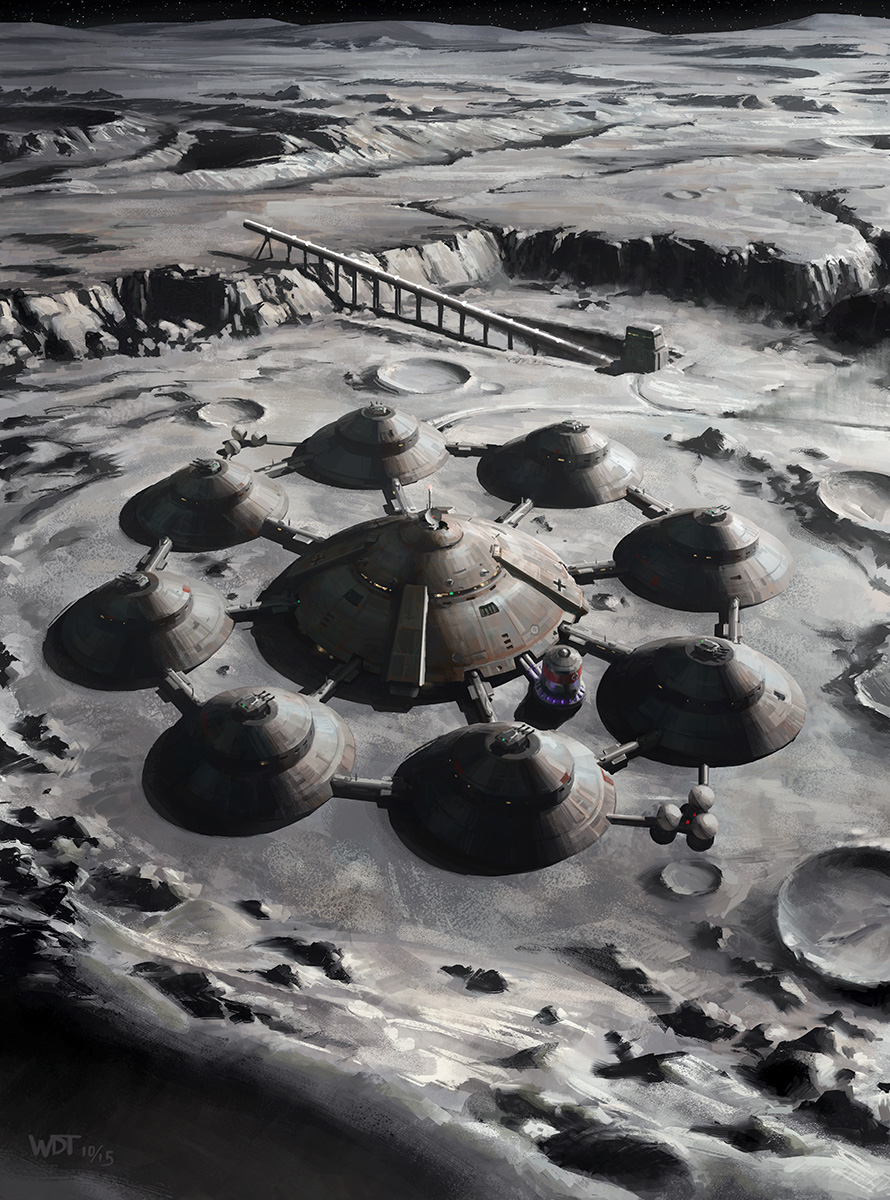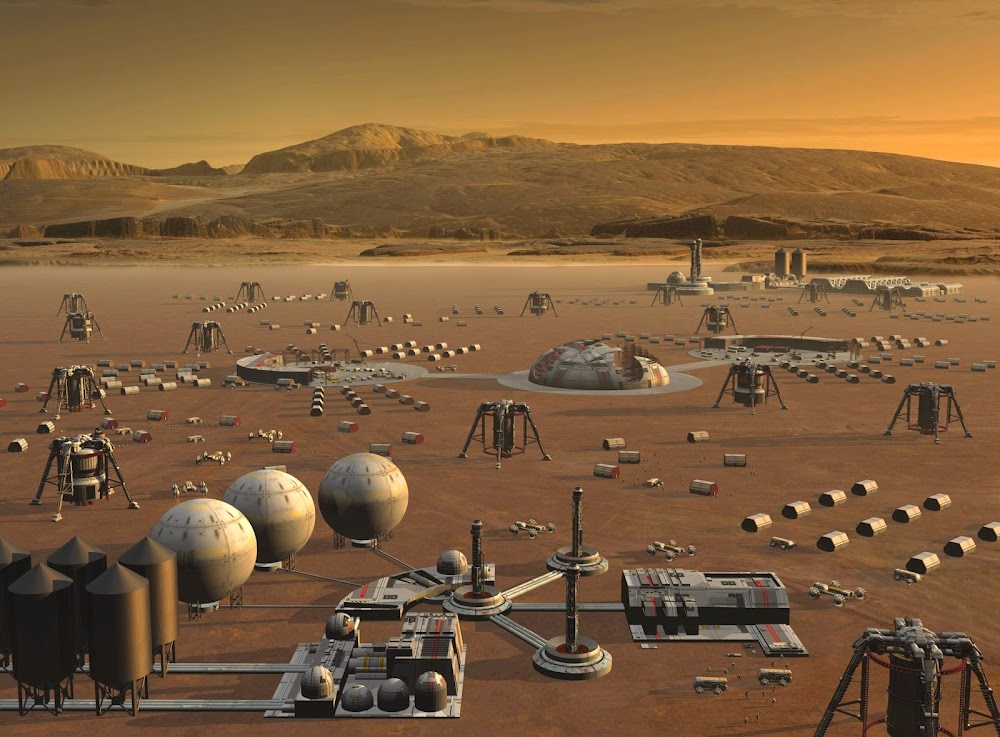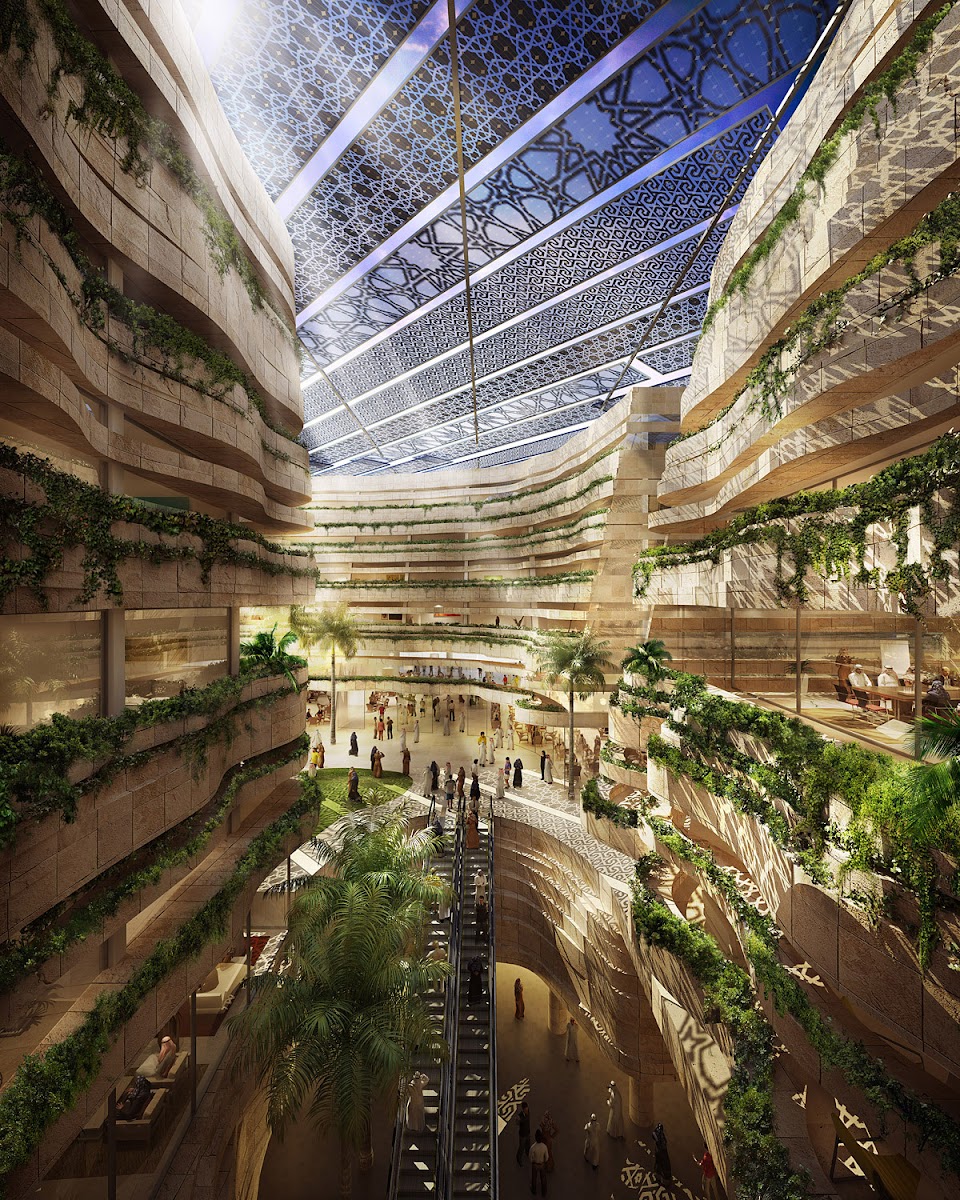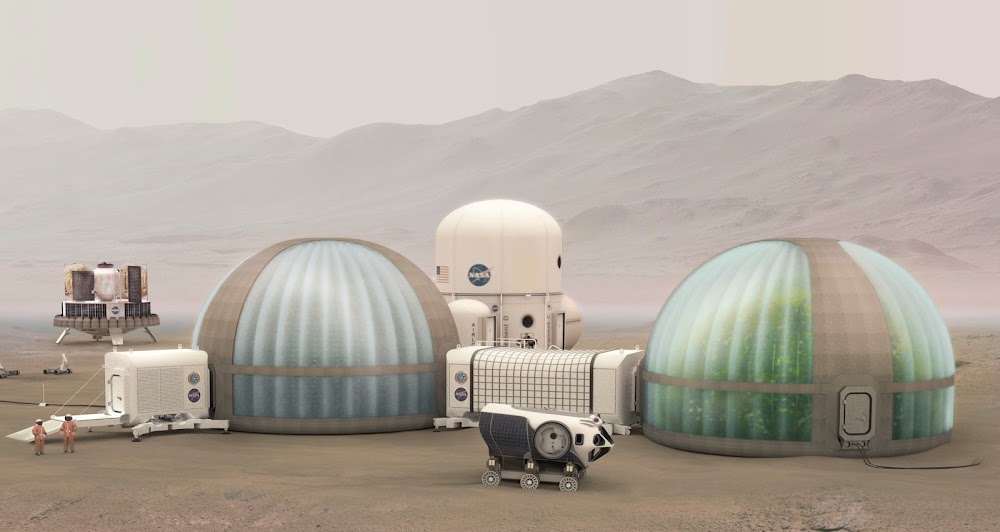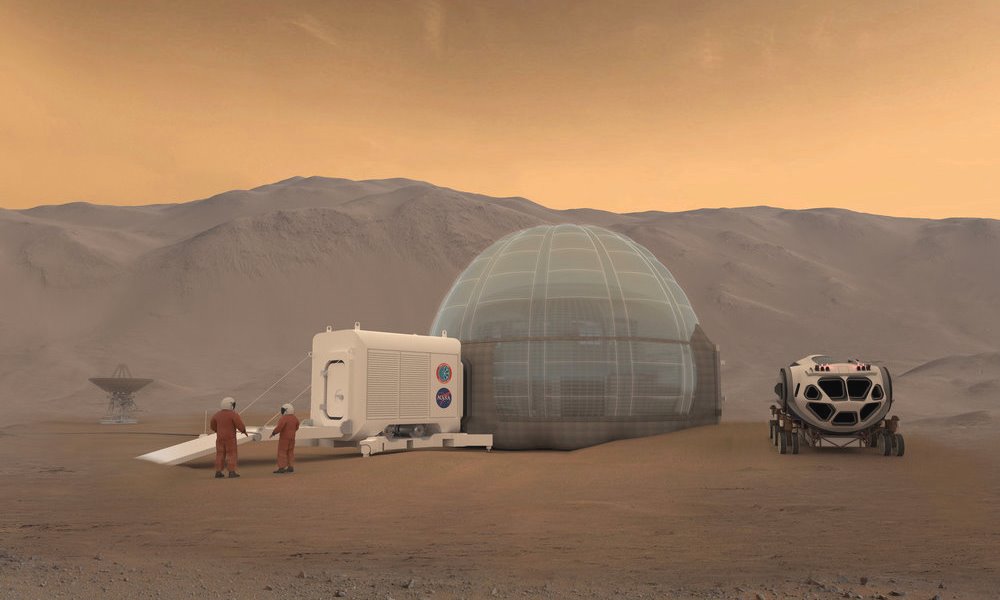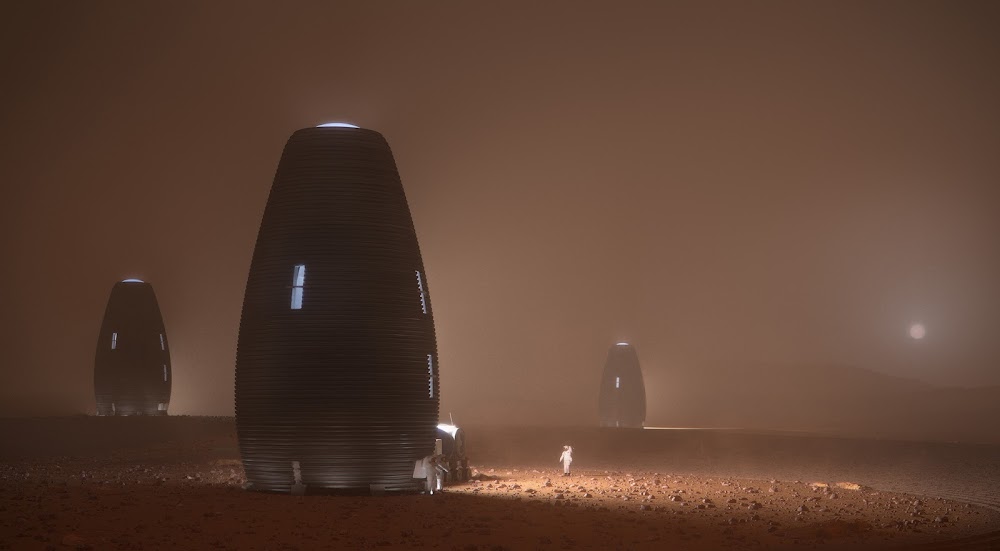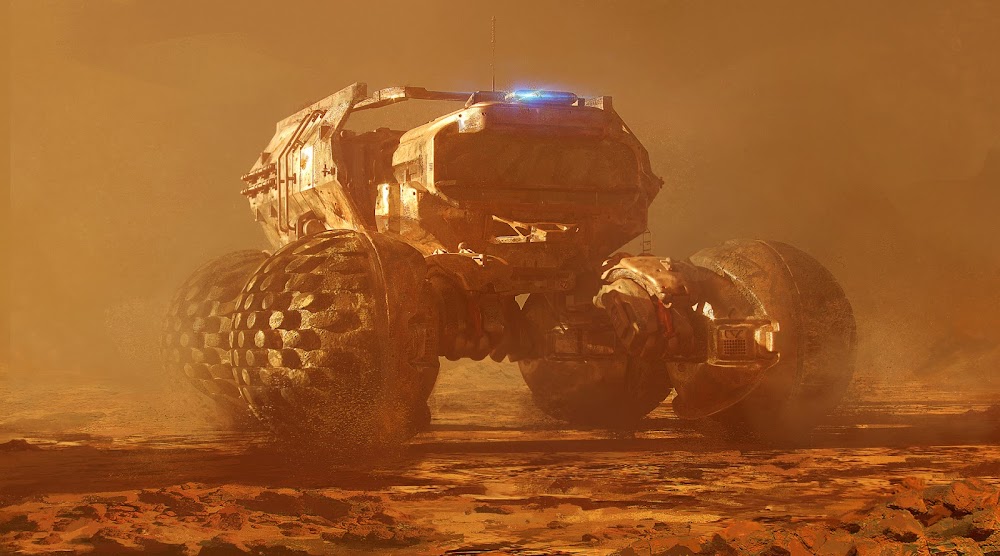Today 50 years ago the most powerful rocket ever built - Saturn V - launched first astronauts to set foot on the Moon. But right now the leading NewSpace company SpaceX is building even more powerful rocket for Mars - Starship & Super Heavy. SpaceX is hoping it to be operational in 2021.
Here is a poster by Gravitation Innovation with Saturn V and SpaceX Starship at launch pad. Note the Starship is at front so it appears a lot bigger than Saturn V at back. In reality the difference in height is minimal with Saturn V being 111 m high and Starship & Super Heavy at 118 m by current design which is subject to change.
Tuesday, July 16, 2019
Saturday, July 13, 2019
Mars rover returning to lander by Jaroslaw Marcinek
Picture of the Day 13/7/2019 - Mars rover returning to a lander by Polish freelance illustrator Jaroslaw Marcinek. More of his art here.
Tuesday, July 9, 2019
Nazi Moon base by Darren Tan
Singaporean freelance illustrator Darren Tan visualizing the conspiracy theory of a secret Nazi base on the far side of the Moon.
This alternate history science fiction myth was somewhat started by Rocket Ship Galileo, a 1947 young adult novel by Robert Heinlein, which features three teenagers who travel to the Moon and discover a secret Nazi base. Since then the "secret Nazi Moon base" cultural myth has been used in fiction frequently, including The Man in the High Castle novel (1962) by Philip K. Dick (and its recent TV series adaptation), Iron Sky movie (2012) and Wolfenstein: The New Order video game (2014). We should remember that Von Braun's V-2 rocket was the first man made object reaching outer space in June, 1944, and it was the base for both US and Soviet space programs. So the myth had some logical grounds.
This alternate history science fiction myth was somewhat started by Rocket Ship Galileo, a 1947 young adult novel by Robert Heinlein, which features three teenagers who travel to the Moon and discover a secret Nazi base. Since then the "secret Nazi Moon base" cultural myth has been used in fiction frequently, including The Man in the High Castle novel (1962) by Philip K. Dick (and its recent TV series adaptation), Iron Sky movie (2012) and Wolfenstein: The New Order video game (2014). We should remember that Von Braun's V-2 rocket was the first man made object reaching outer space in June, 1944, and it was the base for both US and Soviet space programs. So the myth had some logical grounds.
Saturday, July 6, 2019
Building an industrial complex on Mars by William Black
To survive on Mars longterm humans will need to live off the land (a practice in space exploration called In Situ Resource Utilization or shorter ISRU), so we will need to extract, process and store local resources of the planet. Here is William Black's artistic vision of building an industrial complex on Mars at Syria Planum, located south from Noctis Labyrinthus. More of his space concept art here.
Thursday, July 4, 2019
Mars colony in artificial, domed canyon
Picture of the Day 4/7/2019 - design of what could be a human colony in a narrow, artificial, domed canyon on Mars by LAVA architects. This image was done for a design of Masdar City (next to Abu Dhabi, United Arab Emirates) - a futuristic sustainable city project in development and intended to be a hub for cleantech companies.
Tuesday, July 2, 2019
Mars Ice Home concept by NASA, SEArch+ & Clouds AO
Mars Ice Home is a feasibility study conducted at NASA Langley Research Center in 2016 in collaboration with human-centered space design studio SEArch+ and architects from CloudsAO. Responding to the problem of galactic cosmic radiation being the most significant issue for human health on long duration Mars surface missions, the concept incorporates in situ resource utilization derived water-ice for radiation shielding and as a structural component.
Water, a hydrogen-rich material, is an excellent shielding material for galactic cosmic rays – and many areas of Mars have abundant water ice just below the surface. The Ice Home concept balances the need to provide protection from radiation, without the drawbacks of an underground habitat. The design maximizes the thickness of ice above the crew quarters to reduce radiation exposure while also still allowing light to pass through ice and surrounding materials. The water-ice fills and freezes within cellular pockets of the precision-manufactured inflatable membrane. The interior of the habitat would be insulated from the ice with a cellular layer of carbon dioxide, which can easily be extracted from the Martian atmosphere.
Water, a hydrogen-rich material, is an excellent shielding material for galactic cosmic rays – and many areas of Mars have abundant water ice just below the surface. The Ice Home concept balances the need to provide protection from radiation, without the drawbacks of an underground habitat. The design maximizes the thickness of ice above the crew quarters to reduce radiation exposure while also still allowing light to pass through ice and surrounding materials. The water-ice fills and freezes within cellular pockets of the precision-manufactured inflatable membrane. The interior of the habitat would be insulated from the ice with a cellular layer of carbon dioxide, which can easily be extracted from the Martian atmosphere.
Sunday, June 30, 2019
3D-printed Mars habitat MARSHA by AI SpaceFactory
Architectural and technology design agency AI SpaceFactory is the team that won NASA’s 3D-Printed Habitat Challenge for Mars. Their design "MARSHA" of an egg-shaped, dual shell habitat is a principal rethinking of what a Martian habitat could be - not another low-lying dome or confined, half-buried structure but a bright, multi-level, corridor-free home that stands upright on the surface of Mars.
Here are some impressive conceptual design images for the project:
Here are some impressive conceptual design images for the project:
Thursday, June 27, 2019
NatGeo's MARS TV series: drama part of full season 2
Most of the criticism against National Geographic Channel's MARS TV series is related to the concept of joining drama with documentary. In a result the viewer can't fully enjoy any of the two parts without interruptions from the other part every few minutes. So here you can watch only the drama part of full season 2 of the show without documentary cut-ins.
In season 1 the series depicted first human mission to Mars and hardships of building a base on Mars in a lava tube. Season 2 is digging deeper into the challenges of life on Mars, covering everything from the first Martian-born baby to surviving the common cold to the first commercial efforts by Lukrum Corporation to exploit the planet's resources.
In season 1 the series depicted first human mission to Mars and hardships of building a base on Mars in a lava tube. Season 2 is digging deeper into the challenges of life on Mars, covering everything from the first Martian-born baby to surviving the common cold to the first commercial efforts by Lukrum Corporation to exploit the planet's resources.
Watch full episodes of the show here:
Tuesday, June 25, 2019
ESA's base on Mars by Martin Kornmesser
Picture of the Day 25/6/2019 - Concept image of European Space Agency's (ESA) base on Mars by German graphic designer Martin Kornmesser.
Friday, June 21, 2019
Mars exploration rover by Sergii Golotovskiy
Picture of the Day 21/6/2019 - Mars exploration rover in a sandstorm by Polish concept artist Sergii Golotovskiy. More of his art here.
Subscribe to:
Posts (Atom)



